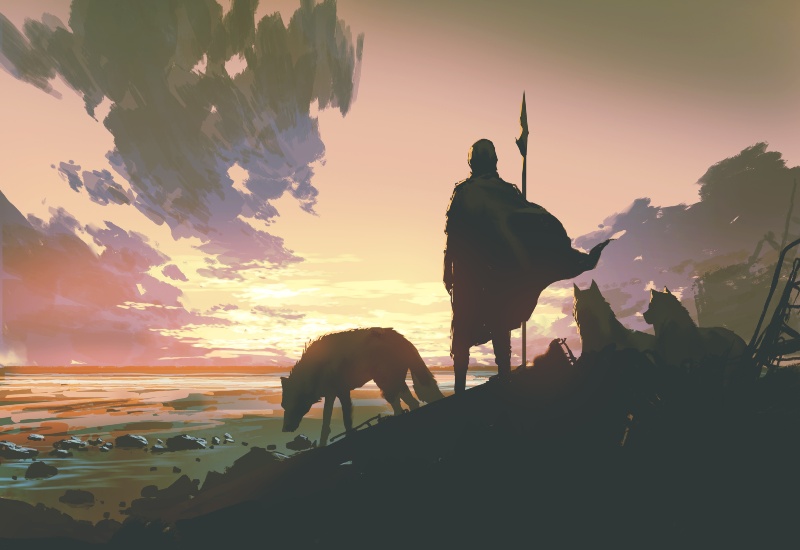Dogs, Wolves, and Humans: A Tale of Mutual Domestication
Understanding Dog Domestication
Dogs are our loyal companions, our protectors, and even our family. But have you ever wondered how these incredible animals became “man’s best friend”? Dog domestication is an extraordinary tale of mutual benefit, survival, and companionship spanning thousands of years. From wolves to wagging tails, this incredible history is filled with fascinating developments. We’ll help you understand the history of dog domestication, its evolutionary roots, and its modern-day implications. Whether you’re a lifelong dog lover or a curious animal enthusiast, this will leave you with a deeper appreciation for the bond between humans and canines.

The Evolutionary Link Between Wolves and Dogs
Dogs may seem far removed from their wild ancestors, but they’re closer to wolves than you might think. Genetic studies have shown that modern dogs, Canis lupus familiaris, share a common ancestry with gray wolves, Canis lupus. The transformation from wild predator to beloved pet wasn’t instant—it occurred over thousands of years through mutual domestication. Here are some key evolutionary connections between wolves and dogs:
- Genetic Overlap: DNA evidence confirms that dogs and wolves split from a common ancestor around 20,000-40,000 years ago.
- Behavioral Similarities: Wolves live in packs with a social hierarchy, similar to the way dogs form attachments and display loyalty to their human families.
- Physical Traits: Early domesticated dogs resembled wolves with similar size, fur patterns, and hunting prowess. Over time, selective breeding introduced the diverse physical traits we see in dogs today.
How Mutual Domestication Occurred
The domestication of the dog was a process where both humans and wolves benefited, leading to gradual behavioral and genetic changes. This cooperative relationship represents one of the earliest examples of humans partnering with animals. It paved the way for dogs to play a vital role in human society. Here’s an outline of how this process unfolded over millennia.
- Early Encounters (~30,000 years ago): Wolves likely began scavenging near human settlements for food scraps. Friendly, less aggressive wolves were more likely to approach humans without fear.
- Mutual Benefits (20,000–15,000 years ago): Humans benefited from having wolves nearby—wolves helped warn against dangers and scare off predators. Meanwhile, wolves gained a reliable food source and protection from humans.
- Behavioral Changes (15,000–10,000 years ago): Wolves that displayed lower aggression and greater social cooperation adapted better to living near humans. Over time, these tamer wolves were selectively bred, strengthening their connection to humans.
- Early Domesticated Dogs (9,000 years ago): Genetic adaptations occurred, leading to physical and behavioral traits, such as floppy ears, smaller size, and increased trainability.
The Role of Dogs in Human Society
Once wolves became domesticated dogs, their role in human life expanded significantly. No longer limited to scavenging, dogs provided a range of services that made them indispensable. Here’s a glimpse into the historical roles that domesticated dogs have played throughout centuries:
- Guardians: Early humans relied on dogs to protect their camps and livestock. Dogs barked to warn of intruders or predators, providing crucial security.
- Hunters: Dogs with exceptional scent and tracking abilities assisted in hunting animals for food. Many hunting breeds we see today originated from these roles.
- Companions: Even in ancient times, dogs offered emotional comfort and companionship. Archeological evidence suggests that humans buried their dogs with care as part of rituals.
- Transport Partners: Certain breeds of dogs helped pull sleds and carry supplies in Arctic regions, highlighting their adaptability to extreme conditions.
- Healers & Spiritual Symbols: Different cultures assigned dogs spiritual and healing properties. Some civilizations believed dogs had supernatural powers or acted as guardians in the afterlife.
Modern-Day Implications
Today, the domestication of dogs continues to influence our lives profoundly. While their ancient roles as hunters and guards have evolved, dogs have adapted to meet modern human needs. Genetic research and training advances have further expanded how we interact with and care for these creatures. For example, DNA testing kits allow pet owners to learn more about their furry friends’ breed history and health risks. By understanding the milestones in the timeline of dog domestication, we can better appreciate the resourceful, empathic, and devoted creatures that dogs are today. Here are some of the ways dogs complement our daily living:
- Service Animals: Dogs now serve as service animals for individuals with disabilities, including guiding the visually impaired and detecting seizures.
- Therapy Companions: Therapy dogs provide emotional support in hospitals, schools, and senior care facilities.
- Police & Military Work: K-9 units specialize in detecting drugs, explosives, and missing persons, showcasing the advanced training capabilities of modern dogs.
- Family Pets: More than 48 million households in the U.S. own at least one dog. This companionship improves mental health and fosters a sense of purpose and connection. Whether you’re looking to adopt or buy a dog from a breeder, we’re happy to help guide the process.
Bringing a Dog into Your Life
The story of ancient dog domestication reminds us of the intricate partnership between humans and animals—a connection built on mutual trust and cooperation. If you’re considering adopting a puppy, remember that you’re joining a tradition tens of thousands of years in the making. At Hilton Butler Inc., we believe in fostering strong relationships between pets and their families. Residents near Frisco and Allen, TX, can contact us for professional pet care advice, training resources, and more. Whether you’re welcoming a puppy into your life or curious about how dogs became part of the human story, the bond between our species is nothing short of extraordinary. Take the first step toward building your unbreakable bond with a dog. Learn more about pet adoption or care by contacting us today.
